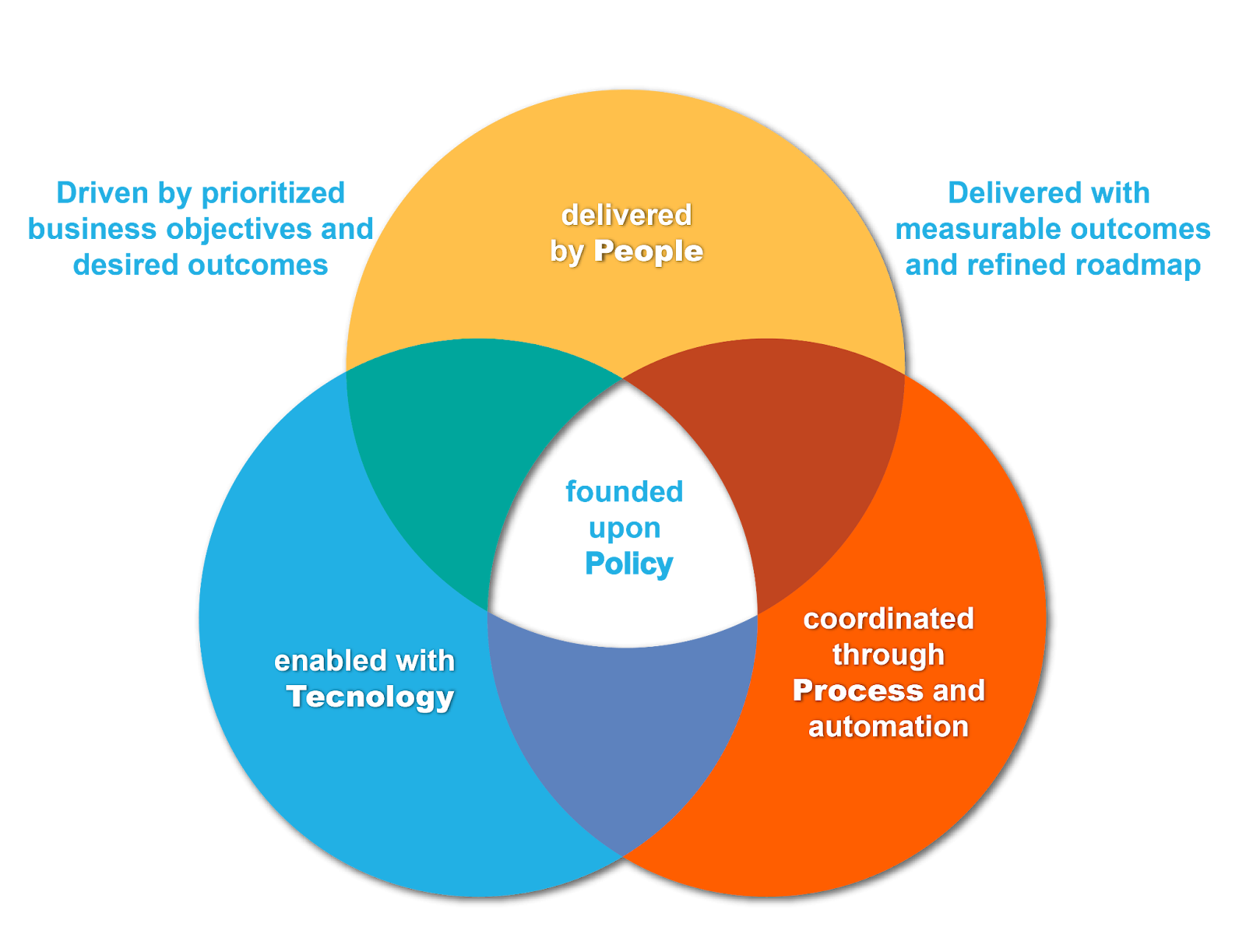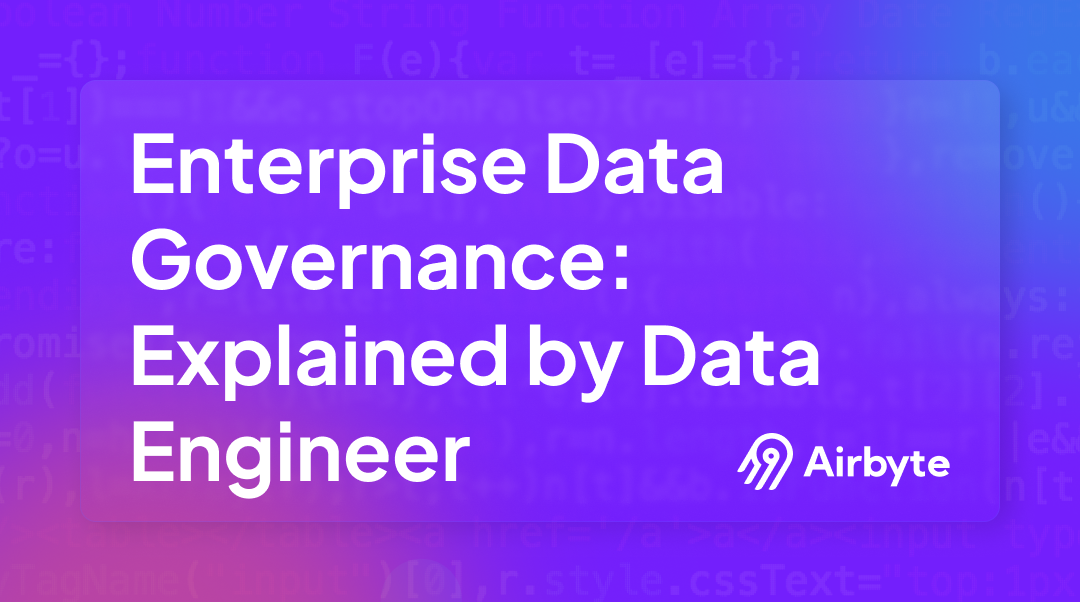What is Enterprise Data Governance? Explained by Data Engineer
Summarize this article with:
✨ AI Generated Summary
Enterprise data governance (EDG) establishes policies and procedures to ensure data quality, security, and compliance, enabling better decision-making and regulatory adherence. Key benefits include improved data visibility, regulatory compliance, cost reduction, enhanced data integrity, and increased organizational agility.
- Steps to implement EDG: understand data scope, validate data, define security needs, assign roles, set policies, select tools, track KPIs, and monitor continuously.
- Challenges include data silos, balancing access with security, proving business value, and adapting to evolving regulations.
- Best practices: align governance with business goals, automate processes, assign clear ownership, start small and scale, communicate regularly, and measure progress.
- Top tools: Collibra, Erwin, IBM Data Governance, Ataccama, Alation, and Airbyte for data integration.
Many enterprises are becoming increasingly reliant on data as a critical asset for driving business strategies. They value data for its ability to help analyze trends, predict future outcomes, and streamline business operations.
With vast amounts of data assets being generated and consumed by enterprises, including big data, there are higher chances of inconsistencies and discrepancies leaking into the data infrastructure. Without a robust enterprise data governance framework, unregulated data ingestion can lead to biased or erroneous outcomes.
In this article, you will learn about enterprise data governance, its benefits, challenges, and best practices from the perspective of a data engineer. We will explore how data quality management and the right governance programs can help unlock the full potential of your organizational data, ensuring consistency, security, and compliance. You will also explore the top data governance systems and vendors you can leverage to gain a competitive edge in the market.
What Is Enterprise Data Governance?
Enterprise data governance involves establishing comprehensive policies and procedures to ensure that your organization’s data assets remain high-quality, secure, and trusted. It sets rules to oversee how data is created, stored, accessed, and used throughout its lifecycle. The process of data governance ensures that data integrity is maintained, data security is ensured, and data sharing is both controlled and efficient across departments.

Enterprise data management encompasses defining roles and responsibilities for data stewardship, setting data quality management standards, and implementing security measures to protect sensitive data.
Through effective data governance, you ensure everyone in your organization is aligned on data access, storing data, and maintaining data integrity, which leads to improved decision-making and smoother regulatory compliance with regulatory requirements.
Benefits of Enterprise Data Governance
Implementing enterprise data governance can offer numerous benefits that directly impact operational efficacy and the bottom line. Here’s a closer look at some of the advantages:
Improved Data Visibility and Traceability
EDG increases data visibility through metadata management, data cataloging, and data lineage. This allows you to find specific datasets across the organization and track how it is transformed and used. Data lineage also provides insight into the quality of data by helping to pinpoint where data issues arise within your processes.
Regulatory, Legal, and Industry Compliance
Data privacy regulations like GDPR, PII, and industry-specific standards have complex requirements for data handling. Enterprise data governance helps you comply with these regulations and ensures you have a documented process for managing data access and audits. Compliance with these regulatory requirements is fundamental to mitigating risks associated with data breaches.
Reduced Costs
Investing in enterprise data governance programs can save your organization money in the long run. Proper data management and the elimination of data redundancies reduce storage costs and increase overall efficiency. Governance also protects your business from the risk of fines associated with data breaches.
Enhanced Data Quality and Integrity
A robust data governance strategy enhances your data quality by improving consistency, completeness, and accuracy. This fosters confidence in the insights you derive from your data quality management processes and increases trust in the business decisions based on those insights. This is crucial for maintaining data integrity across all levels of the organization.
Innovation and Agility
With a well-governed data ecosystem, you can swiftly adapt to evolving market needs and capitalize on emerging opportunities. Data governance programs enable innovation by ensuring your teams can access accurate and reliable data when needed. This flexibility helps you maintain a competitive edge and respond to big data challenges effectively.
Steps to Develop an Enterprise Data Governance Framework
An enterprise data governance roadmap serves as the foundation for your organization’s data strategy. It outlines a blueprint for managing data flows across various systems while accommodating specific data security regulations, industry protocols, and governance needs.
Below are key steps to create a robust data governance system:
Understand Your Organization’s Data and Its Scope
Start by identifying your data sources and defining the types of data your organization manages. This can include master data, transactional data, analytical data, and unstructured data. Understanding the scope ensures that you properly manage organizational data across departments and optimize data systems.
Establish Data Validation Processes
Implement procedures to ensure data quality and relevance throughout its lifecycle. This may include validation checks for data formats, version control, and quality control during various stages, such as data entry, transformation, storage, and reporting.
Determine Risk and Security Requirements
Establish risk profiles for different types of data and implement appropriate security measures based on their sensitivity. Use tools such as data encryption, access controls, and Data Loss Prevention (DLP) systems to protect sensitive data from unauthorized access.
Define the Organizational Structure
Clearly outline the roles and responsibilities involved in data stewardship across the organization. This includes defining data governance roles, such as the Chief Data Officer, data owners, data stewards, and other representatives across business units. Proper data ownership ensures accountability and helps maintain data integrity.
Set Data Standards and Policies
Set policies and guidelines that govern data access, data sharing, and data storage to ensure consistency and compliance across your organization. These policies should outline the desired outcomes of data governance and establish the protocols to follow for data handling.
Select Tools and Technologies for EDG Implementation
Choose the most suitable tools to implement your governance framework. Consider solutions for master data management, metadata management, and automated data quality management to ensure that enterprise data remains consistent and reliable.
Track Key Performance Indicators (KPIs)
Define the KPIs for tracking the success of your data governance initiatives. These can include measures for ensuring data quality, efficiency improvements, and cost savings from eliminating data silos. Ensure you have metrics in place to assess data management efforts across the organization.
Implement Monitoring and Improvement Processes
Establish mechanisms to continuously monitor the effectiveness of your data governance strategy. Perform compliance audits, collect stakeholder feedback, and review governance processes regularly to keep them up to date.
Challenges in Enterprise Data Governance
While data governance is critical for maximizing the value of your organization’s data assets, implementing and managing an effective EDG framework can be challenging. Some key challenges include:
Data Silos
Data silos often arise when different departments access specific datasets, leading to inefficiencies and barriers to effective data sharing across the organization. Overcoming this challenge requires collaboration and transparency across business units.
Balancing Accessibility and Security
Striking the right balance between providing data access to authorized teams while ensuring data security can be difficult. Too many restrictions can hinder productivity, but being too lenient can expose sensitive information.
Demonstrating Tangible Business Value
Justifying investments in enterprise data management and governance can be difficult as its impact is not always immediately visible. However, measuring data quality improvements, operational efficiencies, and reduced compliance risks can help demonstrate the value.
Evolving Compliance Regulations
As regulations change, your data governance systems must remain adaptable. This requires a flexible approach to accommodate regulatory shifts while maintaining data quality and security.
5 Best Practices for Enterprise Data Governance
To successfully implement enterprise data governance, keep these best practices in mind:
Align with Business Goals and Automate
Ensure that your data governance programs are aligned with your business objectives. Automate processes wherever possible to streamline operations and reduce errors, helping maintain data integrity.
Assign Clear Ownership and Accountability
Assign specific ownership and accountability for data stewardship across your organization. Clear ownership ensures that data governance roles are respected and that data quality is maintained.
Start Smart and Scale Up
Begin with a small pilot project in a specific data domain, proving its value before scaling across your organization. This ensures successful data quality management before full implementation.
Communicate, Collaborate, and Educate
Regularly communicate the importance of data governance to stakeholders. Equip employees with the knowledge to manage and protect data assets, ensuring that data management efforts are aligned with organizational goals.
Measure, Monitor, and Adapt
Regularly track progress through metrics such as data quality ensuring and adapt your governance framework as needed. Use feedback to improve data governance processes continually.
Top Enterprise Data Governance Tools and Vendors
Several data governance tools can help streamline the implementation of enterprise data governance systems:
- Collibra: Centralized platform to manage data assets, lineage, and access controls, ensuring visibility and simplifying governance processes.
- Erwin: Data modeling tool that captures data relationships and enforces data quality standards.
- IBM Data Governance: Suite of tools for cataloging, lineage tracking, and quality monitoring, ensuring the trustworthiness of data.
- Ataccama: Comprehensive data management platform offering data profiling, cleansing, and governance capabilities.
- Alation: Machine learning-powered tool for metadata management and collaborative governance.
Airbyte: Streamlining Data Movement for Enterprise Data Governance
Before implementing data governance tools, consolidating data from multiple sources is key. Airbyte simplifies this process by enabling efficient data integration, ensuring the accuracy and consistency of your data for governance applications.
Airbyte’s no-code ELT platform supports over 600+ pre-built connectors and allows you to create custom connectors with the Connector Development Kit. It integrates seamlessly with platforms like dbt (Data Build Tool) for complex transformations within existing workflows, ensuring data quality is maintained.

Take Control of Your Data Governance Strategy
Enterprise data governance is essential for organizations seeking to maximize their data assets. By integrating data governance systems with a comprehensive data governance roadmap, businesses can enhance operational efficiency, improve decision-making, and ensure that their data management strategies align with compliance and regulatory standards.
Prioritizing data governance today ensures that your data remains a trusted, secure, and valuable asset for the future.
Frequently Asked Questions (FAQ)
What is the significance of data governance in ERP systems?
Effective data governance ensures consistent and accurate data across all enterprise resource planning (ERP) modules, facilitating reliable reports and informed decision-making.
What are examples of effective data governance strategies?
Effective strategies include data classification, assigning data stewardship roles, and implementing data lifecycle management practices to maintain data quality.
Is it the role of Enterprise Architecture (EA) to promote Data Governance (DG)?
Yes, Enterprise Architecture (EA) defines standards and provides a framework for managing and governing data across the organization, ensuring consistency and governance across business processes.

